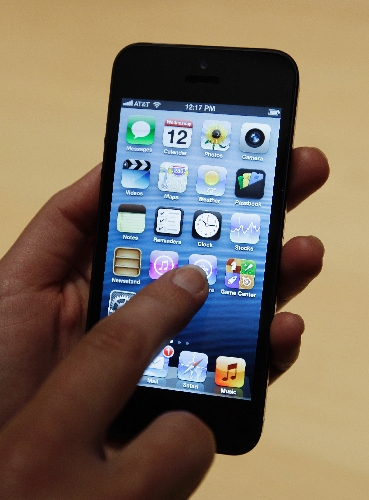Apple Maps users can’t get there from here in Southern Nevada
Folks using Apple's new Maps application to make a road trip to Arizona by way of the Hoover Dam bypass Friday needed to be careful: That first dip was a doozy.
Rather than showing a concrete bridge, the troubled application, which debuted last week, presented a 3-D image that looked like a Hot Wheels track made of melted, twisted taffy. Access to the span southward began with an approximate 45-degree drop, followed by a short, level patch of roadway before requiring a 45-degree climb into a final, 20-degree sideways-torqued clearance over the Colorado River's other side.
Think that's bad?
Drivers in New York looking to use the George Washington Bridge over the Hudson River on Friday were greeted with a Maps image that made it appear the span had been cut in half lengthwise by a rusty hacksaw. People looking for the Huey P. Long Bridge in New Orleans were given directions to a Home Depot, where it can be assumed some bridge-building material - but not a bridge - could be found.
Bridges weren't the only images affected as Apple continued work to straighten out the problem - and the Hoover Dam bypass - later in the day.
Another app glitch involves judging landscape features by their names. New York's hulking Madison Square Garden arena, for instance, showed up as green park space because of the word "Garden."
Things have gotten so bad over the past week users are flocking to social media to complain and mock and a new Tumblr site, The Amazing iOS 6 Maps, is posting flawed images submitted by users.
All of which led Apple CEO Tim Cook to say Friday that the company is "extremely sorry" for the frustration and it's doing everything it can to make it better. In the meantime, he recommends people use competing map applications to get around.
Cook said in a letter posted online that Apple "fell short" of its commitment to make the best products for its customers.
"Everything we do at Apple is aimed at making our products the best in the world," Cook said. "We know that you expect that from us, and we will keep working non-stop until Maps lives up to the same incredibly high standard."
The Cupertino, Calif., company released an update to its iPhone and iPad operating system last week that replaced Google Maps with Apple's own map application. But users complained that the new map software offers fewer details, lacks public transit directions and misplaces landmarks, among other problems.
It's an unusual misstep for Apple, the world's most valuable company. Apple prides itself on releasing best-of-class products, but there have been mishaps - even under founder and late CEO Steve Jobs, whose dogged perfectionism is legendary. A company apology, analysts believe, would likely have happened under Jobs, too.
"I think they are clearing the air and, more importantly, clarifying why they had to do their own maps," Tim Bajarin, a Creative Strategies analyst who's followed Apple for more than three decades, told The Associated Press. He pointed to the infamous "antennagate" issue of 2010. A problem with the iPhone 4's antenna was causing reception issues when people covered a certain spot with a bare hand. Then-CEO Jobs apologized at the time, though denied there was an antenna problem that needed fixing. Apple quickly recovered.
In his letter, Cook said Apple built a new version of its Maps product to give users what they've been asking for. The new app includes turn-by-turn directions, voice integration and a 3-D Flyover feature.
Google's map application for the iPhone did not give turn-by-turn directions or voice-guided navigation, although its version for Android devices does. Google didn't license its turn-by-turn technology to Apple.
Google, Bajarin said, simply "wouldn't give it" because the turn-by-turn feature gave devices running Google's Android software an obvious advantage over Apple. Maps and navigation are among the most-used features of smartphones.
Google's mapping system also experienced problems in its February 2005 debut, with distorted images and some street map overlays not matching up with the corresponding satellite images. Also, some of the data were entirely wrong or simply out of date.
"The biggest challenge is the currency of the data," Google representative Brian McClendon said at the time.
In March 2008, Google added a feature to edit the locations of houses and businesses.
Cook said Apple's Maps will get better as more people use the app and provide feedback. That's true for all digital maps. Google's wasn't perfect when it launched, but got better over the years as users pointed out mistakes and helped the company collect its vast trove of data used to perfect it.
"Ultimately, what (Apple) discovered early on is that Google had access to 100 million iOS users who helped them build the Google Maps database, Bajarin said. "At some point Apple had to put its foot down."
It came time, he added, for Apple to own their Maps customers - and not Google.
But now, Cook is recommending that users look at other options - including Google's map service.
"While we're improving Maps, you can try alternatives by downloading map apps from the App Store like Bing, MapQuest and Waze, or use Google or Nokia maps by going to their websites and creating an icon on your home screen to their web app," Cook wrote.
Could Apple have avoided the Maps debacle? Bajarin thinks so. After all, the company released Siri, its oft-derided virtual assistant, noting that it was still a work-in-progress and would get better over time. Customers understood.
"Had Apple and Tim Cook and team introduced the maps as a work-in-progress, they wouldn't have the backlash," he says.
The Associated Press contributed to this report.

















